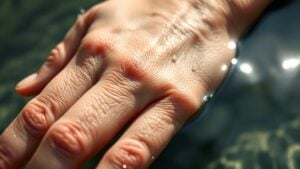Did you know that your fingers can start to resemble prunes in just a few minutes of water exposure? This intriguing phenomenon isn’t merely a quirky trait; it actually aids in enhancing your grip on wet surfaces. But what occurs when those wrinkles persist longer than anticipated? Should you be curious about what your skin could be attempting to communicate, you’re in for an exploration. Allow us to examine the root causes and what you can do about it.
Pruney Fingers
At the instant you dip your fingers in water for too long, you could observe a curious change: they become wrinkled, almost prune-like. This occurs because your nervous system instructs the blood vessels under your skin to constrict, reducing blood flow.
As a result, your fingers channel away extra water, enhancing your grip on wet objects. Fascinatingly, these wrinkles emerge within just five minutes of water immersion and peak around 30 minutes, forming unique ridge patterns.
This response not only protects you but could also assist in maintaining your body temperature. So, each time you see those wrinkled fingers, recall it’s a captivating mix of biology and evolution at work, reminding you how your body adapts to its environment!
Common Causes of Pruney Fingers
At times you spend too much time in water, you could notice your fingers turning wrinkly. This occurs because your body constricts blood vessels, assisting you in gripping slippery surfaces better.
However, did you realize that factors such as cold weather or even particular skin conditions may also make your fingers pruney?
Water Immersion Effects
Have you ever noticed how your fingers turn all wrinkled after a long soak in the tub? This phenomenon, known as pruney fingers, happens due to prolonged water exposure.
At the moment you immerse yourself in warm water, typically around 104°F, your body reacts within about 3.5 minutes. The nervous system triggers blood vessel constriction, reducing fingertip volume, which creates those familiar skin grooves.
It’s a fascinating survival feature! Researchers found that pruney fingers can actually help you grip wet objects more effectively—by up to 12% faster.
You’ll observe these wrinkles forming quickly on your fingertips since they’ve more sweat pores than your palms, making your skin responsive to moisture in no time.
Health Condition Indicators
Though you could believe pruney fingers are merely a quirky result of soaking in the tub, they could occasionally indicate a deeper health issue worth investigating.
Provided your fingers wrinkle persistently without water exposure, dehydration could be the cause. This can happen alongside slow skin rebound upon being pinched.
Additionally, conditions like Raynaud’s disease can trigger pruney fingers, with color changes like white or blue.
Hypothyroidism might leave your skin dry and cool, leading to fine wrinkles.
Finally, autoimmune conditions such as lupus or scleroderma can also result in pruney fingers, often accompanied by other symptoms. Should you notice these signs, it’s essential to speak with a healthcare professional about any foundational medical conditions affecting your immune system.
Medical Conditions Linked to Persistent Wrinkling
Persistent wrinkling of your fingers can be more than just a sign of aging—it often hints at fundamental medical issues that deserve your attention.
For instance, when your fingers wrinkle without water exposure, it could signal Raynaud’s disease, where blood vessels constrict excessively in cold or stressful situations.
Conditions like hypothyroidism can also lead to wrinkly fingertips due to slowed metabolism.
Other issues, such as lymphedema, often after cancer treatment, can cause skin to appear leathery.
Autoimmune disorders like scleroderma and lupus trigger persistent wrinkling through skin thickening or inflamed blood vessels.
Should you notice these changes, it’s wise to consult a healthcare professional for an accurate diagnosis and appropriate care.
The Role of Dehydration in Skin Pruniness
At the time it comes to wrinkly fingers, dehydration plays a significant role that’s often overlooked. Once your skin loses moisture, it can lead to pruney fingers that could surprise you.
Here are some signs to watch for regarding dehydration:
- Skin loses elasticity, making it harder to bounce back.
- You could notice skin tenting, or slow return of pinched skin.
- Dark yellow urine often confirms you need more water.
- Persistent wrinkling without water exposure signals severe dehydration.
To stay hydrated, aim for 2–3 liters of water daily. This helps prevent symptoms of dehydration like wrinkly skin and can support other health factors like maintaining stable blood sugar levels.
Recall, keeping hydrated is key to healthy skin!
Impact of Diabetes and Thyroid Disorders on Skin Health
When you’re managing diabetes or thyroid disorders, you could notice changes in your skin, particularly when it feels dryer or wrinkled. High blood sugar levels can impact your sweat glands, while thyroid imbalances may hinder collagen production, leading to skin that looks aged or pruney.
Grasping these links can assist you in addressing the skin symptoms and sustaining healthier skin in general.
Diabetes Effects on Skin
At the time of managing your health, keeping an eye on your skin can be just as crucial as monitoring your blood sugar levels.
Diabetes can lead to various skin issues due to factors like high blood glucose levels and nerve damage.
Here are a few things to watch out for:
- Dry skin: High blood sugar can damage sweat glands, leaving your skin excessively dry.
- Pruney fingers: You’re at a higher risk of developing pruney fingers due to poor circulation.
- Wrinkled skin: Excessive dryness often leads to more pronounced wrinkles.
- Skin conditions: Diabetics could face a 33% higher risk of various skin conditions.
Thyroid and Wrinkled Skin
Grasping how thyroid disorders intertwine with skin health can feel overwhelming, particularly while managing conditions like diabetes.
Your thyroid gland plays a key role in maintaining skin vitality through thyroid hormones.
In hypothyroidism, reduced sweat production can lead to dry, wrinkled skin, while hyperthyroidism might cause thin, fragile skin due to accelerated metabolism and collagen breakdown.
Both conditions can cause skin changes like puffiness or excessive sweating, affecting your skin’s texture.
Additionally, poorly managed diabetes can exacerbate these issues, as high blood sugar levels damage blood vessels and nerves, leading to premature wrinkling.
Identifying how these factors interact offers you a clearer insight of your skin’s health and potential treatment paths.
Management of Skin Symptoms
Managing skin symptoms associated with diabetes and thyroid disorders can feel overwhelming, but you’re not alone in this path. Here are some practical tips to help you improve your skin health:
- Maintain balanced blood sugar levels: Aim for an HbA1c below 7% to support skin hydration and reduce complications.
- Regular monitoring of thyroid hormone levels: Keep your TSH between 0.5–5.0 mIU/L to boost skin elasticity and hydration.
- Keep your skin moisturized: Use products rich in humectants to combat dryness, particularly in cases of hypothyroidism.
- Stay hydrated: Drink plenty of water to help maintain skin moisture and general health.
With a focused approach on diabetes and thyroid management, you’ll observe improvements over time, making every little step worth it.
Autoimmune Disorders and Their Effect on Finger Appearance
Anytime you’re living with an autoimmune disorder, you could notice some changes in your fingers that are hard to overlook. For instance, Lupus Erythematosus can trigger skin inflammation, making your fingers seem red and swollen. Sjögren’s syndrome frequently results in dry skin, which may leave your fingertips appearing wrinkled.
With systemic sclerosis, the skin thickens, causing fingers to look puffy or shriveled. Should you be managing Dermatomyositis, you may observe purple or red rashes, accompanied by wrinkling.
Additionally, Raynaud’s phenomenon, common in autoimmune diseases, can briefly restrict blood flow, leading to visible wrinkles and color shifts. All these factors pose difficulties, but grasping their impacts can help you feel more in command of your symptoms.
Tips for Treatment and Prevention of Wrinkled Skin
Taking care of your skin can feel like a full-time job, particularly while you’re handling wrinkles, especially on your fingers. To help you combat wrinkled skin, consider these tips:
- Hydration’s Key: Drink at least 2 liters of water daily to enhance skin elasticity and keep wrinkles at bay.
- Moisturize Wisely: Apply moisturizers with hyaluronic acid or glycerin right after water exposure to lock in hydration.
- Glove Up: Wear gloves during dishwashing or cleaning to protect your hands from harsh detergents and prolonged water contact.
- Sunscreen Matters: Use SPF 30+ sunscreen on your hands to shield against UV damage that speeds up aging.





